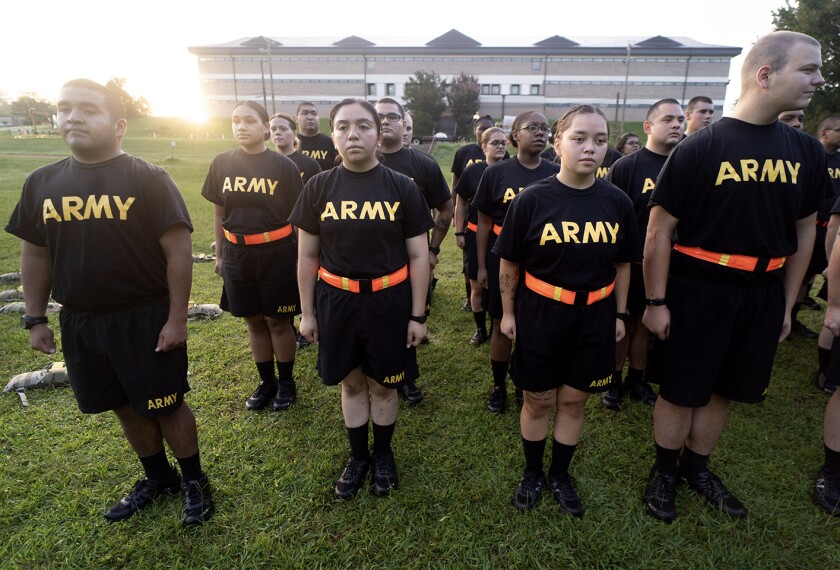A growing number of states track postgraduate college and career outcomes to improve their K-12 education systems. But there’s a conspicuous hole in the data they collect: which students enlist in the military, and how long they serve.
That may seems like a narrow concern, but the lack of clarity has real-world education consequences. Districts can miss out on bonuses for successfully launching kids after high school, and those with a high military presence may receive lower state accountability scores.
The missing data also interfere with states’ efforts to track successful postsecondary pathways at a time of growing interest in understanding students’ next steps after K-12.
Now, a new effort aims to fill in the holes. The Council of Chief State School Officers has organized a coalition of state education leaders and experts who will work with the Pentagon to develop a standardized process for obtaining students’ military data across branches.
Supporters say it will offer an important view into the post-high school outcomes for a sizable group of students. About 70,000 people enlist in the armed forces every year, and about half are recent high school graduates.
“States are trying to answer these questions about how is my education system preparing people for the world of work in my state?” said Kate Tromble, the vice president of federal policy for the Data Quality Campaign, an organization that advocates for improved collection and use of educational data. “Having the military data in fills a gap. It lets states be able to say, Not only are we preparing you to be an engineer, a teacher, a welder, or an electrician; we can also prepare you to be successful in the military.”
The need is real, organizers said. Thirty state chiefs have expressed interest in the effort, called Military Enlistment Data Access to Lift Student Success, or MEDALS. Organizers hope to agree on a protocol and data-sharing plan in time for the 2025-2026 academic year, CCSSO said in an announcement.
There’s no standard process to access student enlistment data
The problem: Branches of the military have no standard process to request or access to student enlistment data, and privacy concerns and a lack of coordinated efforts have forced many states and schools to go without it, Tromble said.
The need for that data is more urgent now as states develop more robust systems to connect data from K-12, higher education, and careers to provide a more complete look at what makes students successful and how schools can move the needle on those outcomes.
These statewide longitudinal data systems securely collect multiple data points about individual students over time and across sectors. That data can be analyzed to look for trends that inform student career planning, school improvement, and policy.
At least 16 states explicitly include military data in their education accountability systems or on their school report cards, the Data Quality Campaign found.
But that data is largely incomplete, said Kansas Education Commissioner Randy Watson, who helped create the MEDALS task force with CCSSO. Schools may rely on voluntary student surveys or piecemeal information from individual military bases, but they lack the kind of empirical data that is available from other sources, like the National Student Clearinghouse, which provides secure, authenticated data about college enrollment and degree attainment.
In Texas, districts can earn bonuses of up to $5,000 in state funding for each student who meets academic success criteria and enrolls in a four-year college, earns an associate degree, earns an industry certificate, or enlists in the military. Because the state cannot obtain uniform military data, its schools must individually verify and certify students’ participation.
Kansas’ school accountability system requires districts to report postsecondary effectiveness rates, with a goal of 70 percent of students who were enrolled in a school system in 9th grade earning either industry-recognized certification or a higher education degree, or continuing their education two years after their projected high school graduation. But districts can’t currently include military data in that measure, Watson said.
Districts with military presence are more heavily affected
“We know statewide that four percent of our students tell us they’re going to enlist,” he said. “In at least three districts, that number can can approach up to 15 percent.”
That means it’s difficult to accurately capture the success of the Derby, Kan., district, which includes the McConnell Air Force Base; the Junction City district, which includes the Fort Riley Army base; and the Leavenworth district, which includes the Fort Leavenworth Army installation. Districts near military bases tend to have higher enlistment rates, even if their graduates are stationed elsewhere, Watson said.
That data gap has not affected the districts’ accreditation status. But it has caused some to miss the chance to be recognized as exceptional school districts, he said.
“We think a military career is a viable postsecondary path—just as viable as going to the University of Kansas and majoring in engineering,” Watson said. “We want to count that, and we want to make sure that students who do that path get credited, which we think then speaks to honoring those students.”
The data may also be useful for the military, by helping aspiring service members to identify the best path to success in their preferred branch, he said.
The MEDALS working group hopes a data-sharing agreement will include information like students’ scores from the Armed Services Vocational Aptitude Battery exam (a standardized test that measures potential enlistees’ academic capabilities, reasoning, and vocational skills), their enlistment date, their highest rank attained, and how long they serve, said Tromble, who is consulting on the effort.
The work “will greatly contribute to preparing young adults for meaningful military-service related opportunities available to them after high school,” said a statement from Ronald T. Keohane, Assistant Secretary of Defense for Manpower and Reserve Affairs. “Our ongoing collaboration will equip leaders with the insights necessary to position military service as an exciting and fulfilling career path.”






